Charles E W Bean, Diaries, AWM38 3DRL 606/271/1 - 1917 - 1938 - Part 1
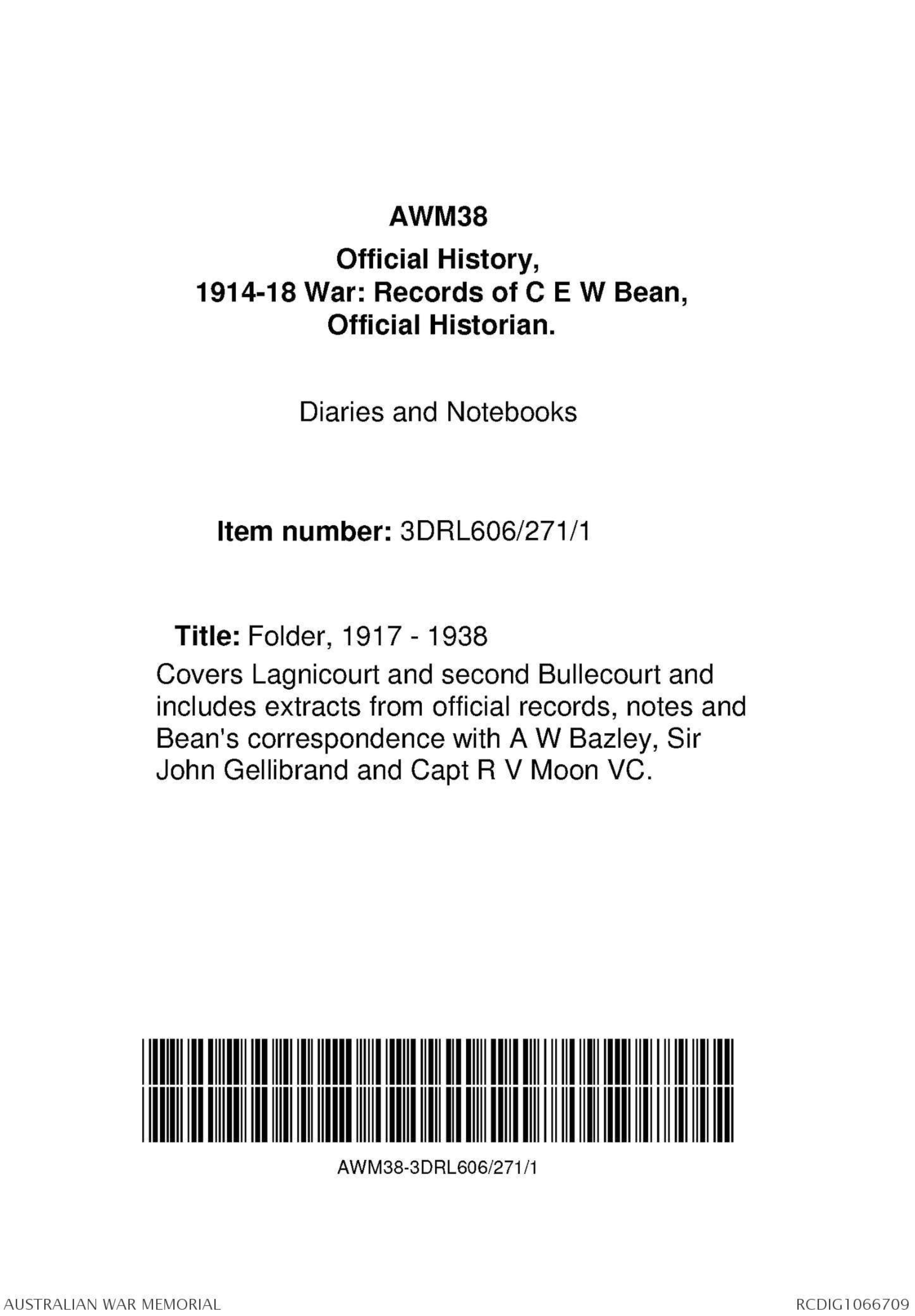
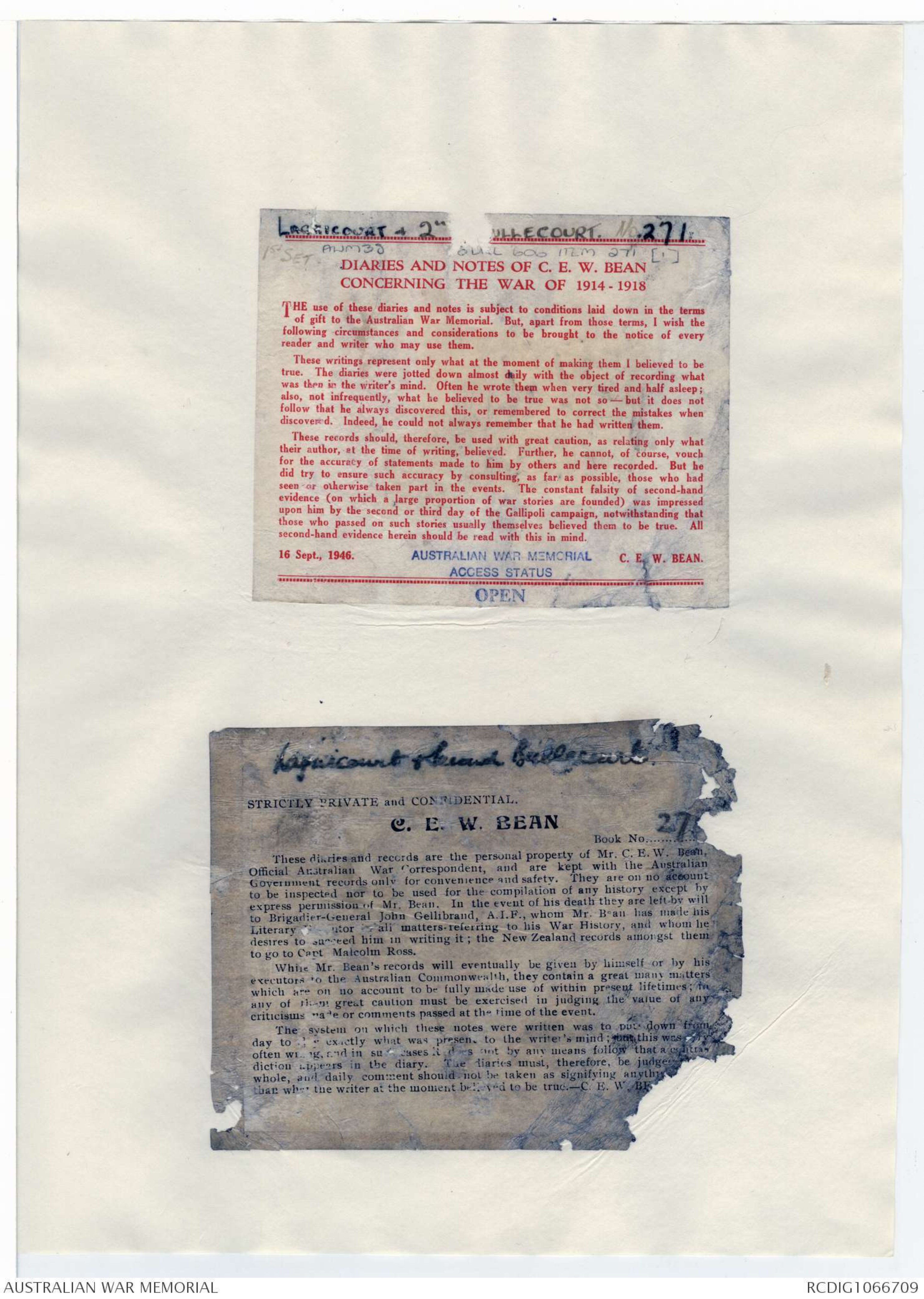
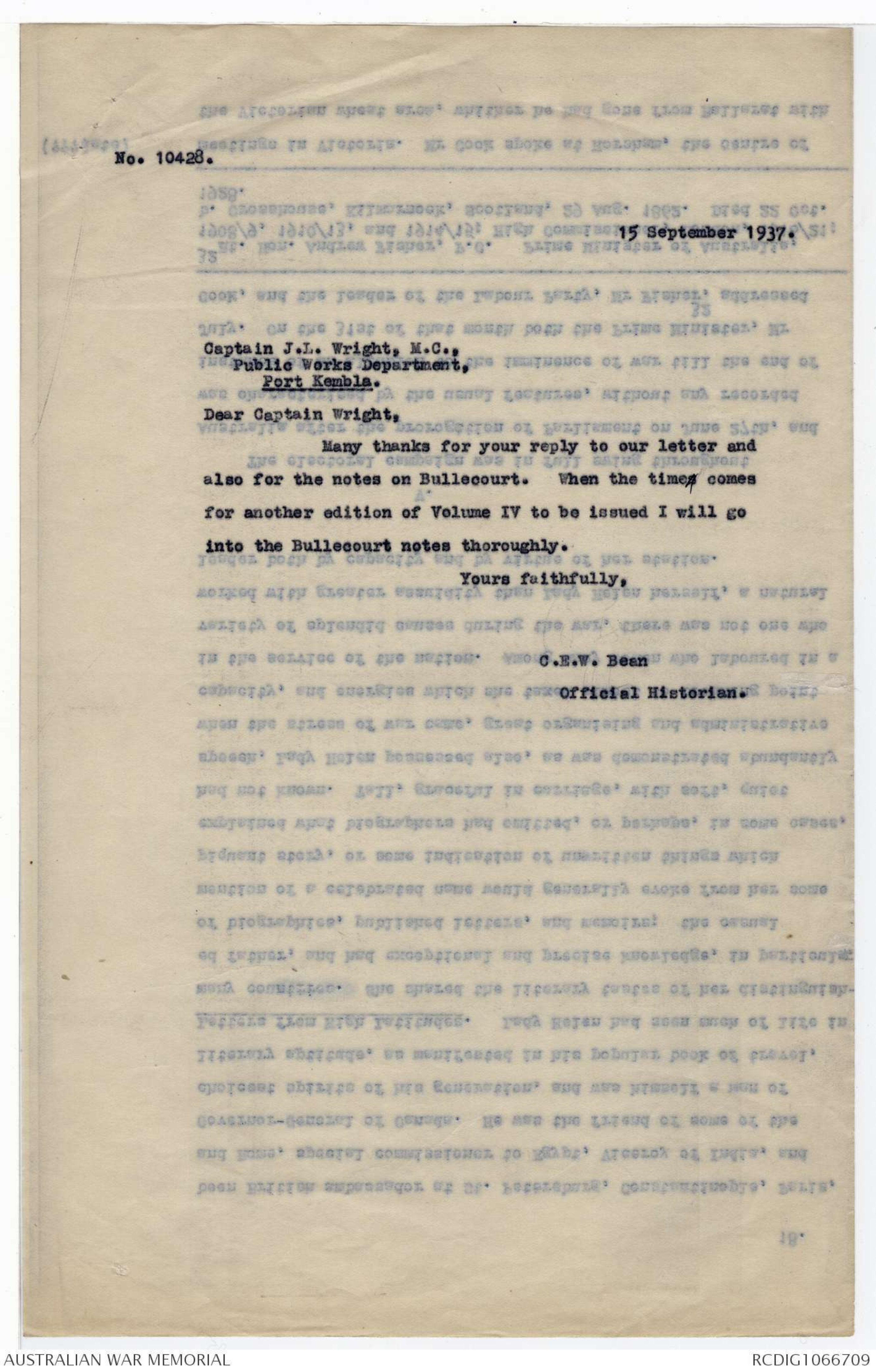
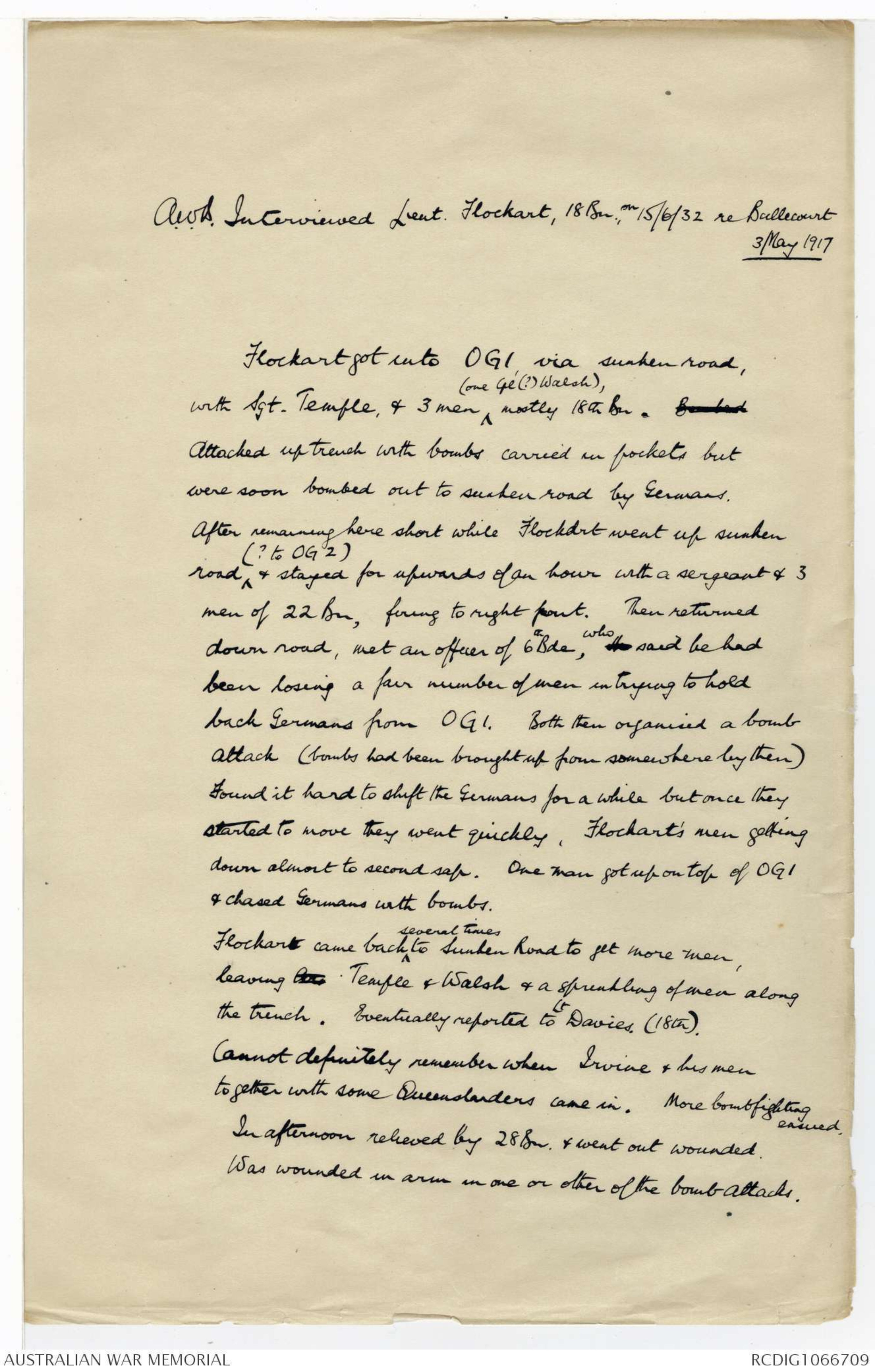
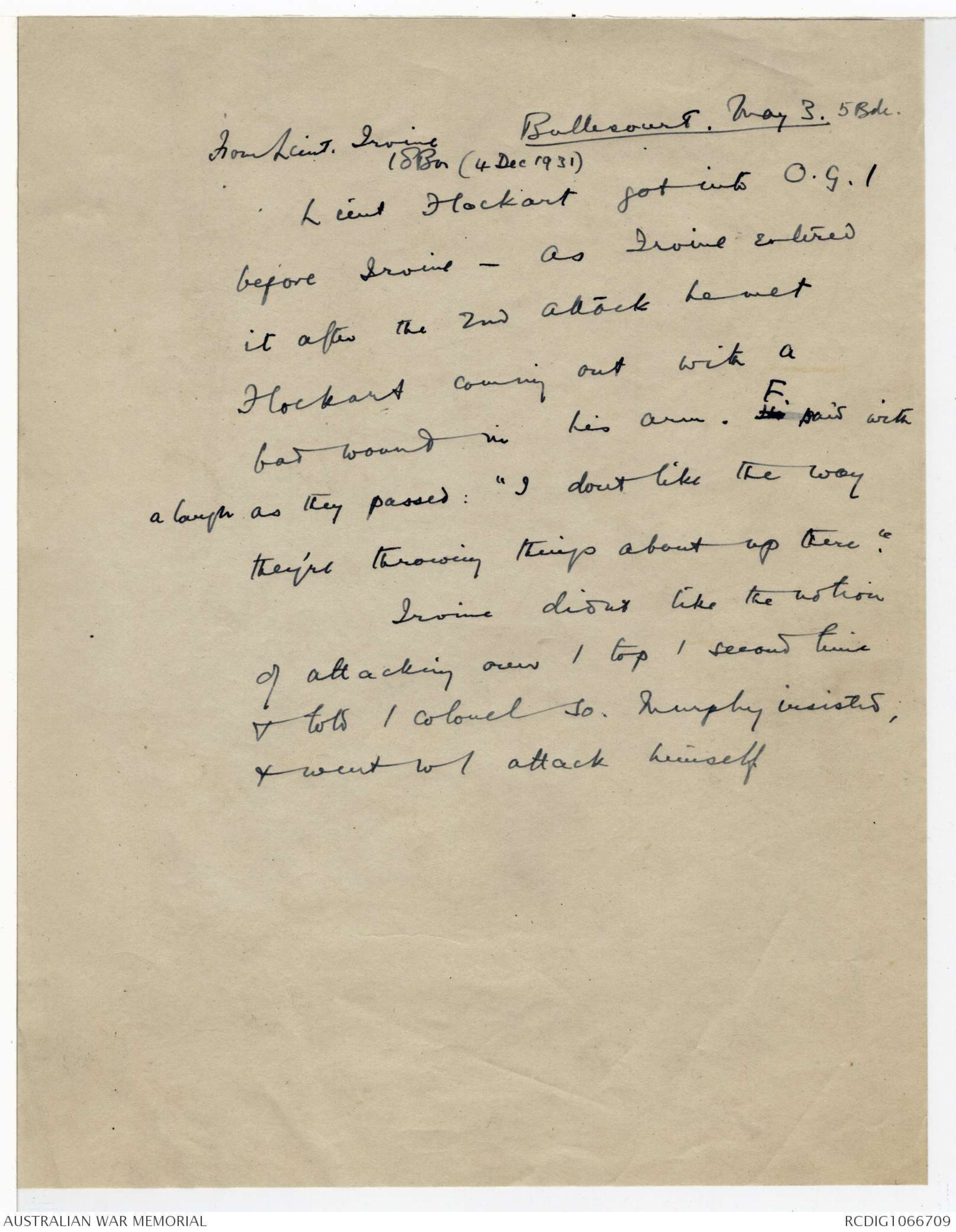


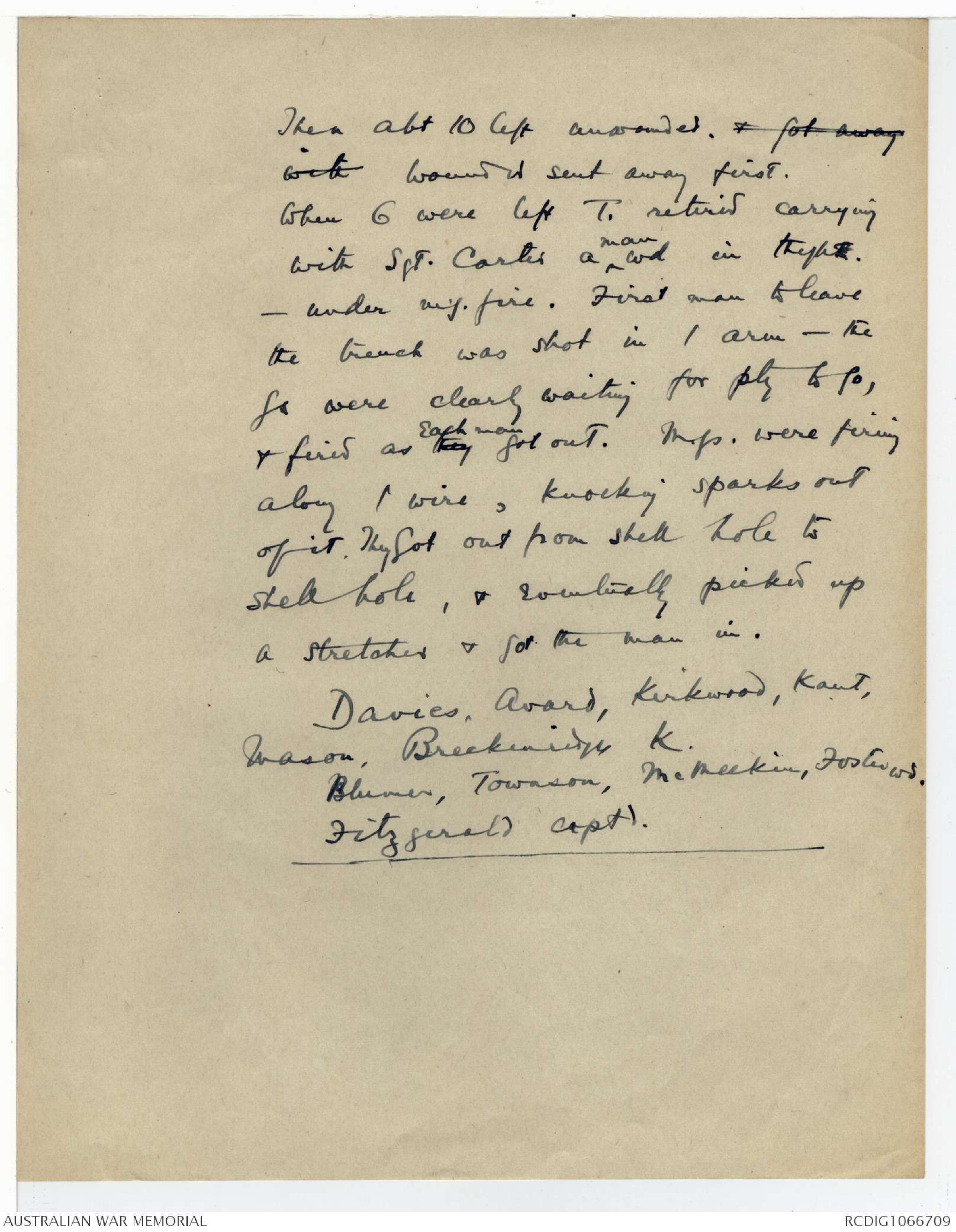

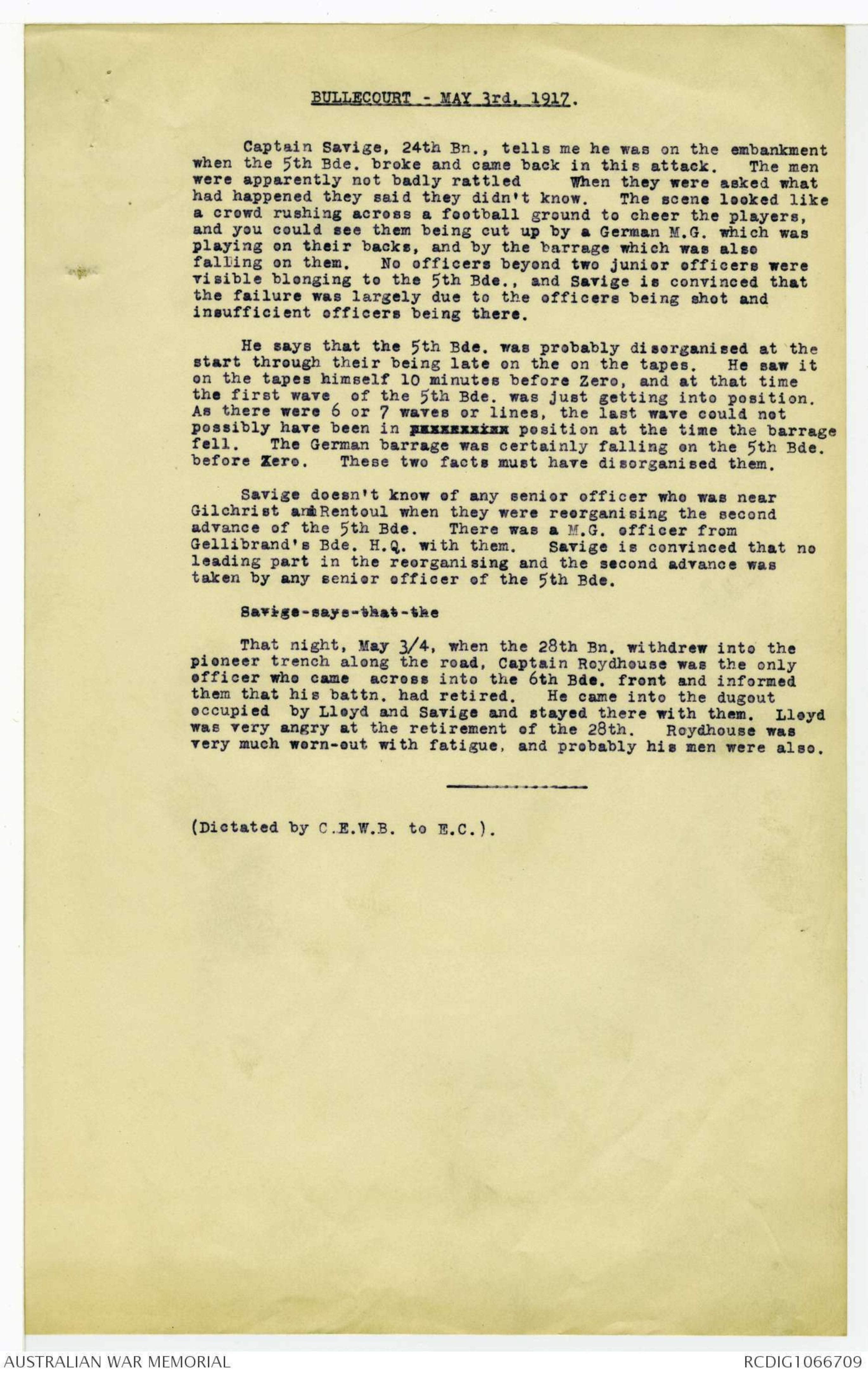
AWM38
Official History,
1914-18 War: Records of C E W Bean,
Official Historian.
Diaries and Notebooks
Item number: 3DRL606/271/1
Title: Folder, 1917-1938
Covers Lagnicourt and second Bullecourt and
includes extracts from official records, notes and
Bean’s correspondence with A W Bazley, Sir
John Gellibrand and Capt R V Moon VC.
AWM38-3DRL606/271/1
LAGNICOURT & 2ND BULLECORT. No. 271
AWM 38 3DRL 606 ITEM 271 [1]
1st SET.
DIARIES AND NOTES OF C. E. W. BEAN
CONCERNING THE WAR OF 1914 - 1918
THE use of these diaries and notes is subject to conditions laid down in the terms
of gift to the Australian War Memorial. But, apart from those terms, I wish the
following circumstances and considerations to be brought to the notice of every
reader and writer who may use them.
These writings represent only what at the moment of making them I believed to be
true. The diaries were jotted down almost daily with the object of recording what
was then in the writer’s mind. Often he wrote them when very tired and half asleep;
also, not infrequently, what he believed to be true was not so — but it does not
follow that he always discovered this, or remembered to correct the mistakes when
discovered. Indeed, he could not always remember that he had written them.
These records should, therefore, be used with great caution, as relating only what
their author, at the time of writing, believed. Further, he cannot, of course, vouch
for the accuracy of statements made to him by others and here recorded. But he
did try to ensure such accuracy by consulting, as far as possible, those who had
seen or otherwise taken part in the events. The constant falsity of second-hand
evidence (on which a large proportion of war stories are founded) was impressed
upon him by the second or third day of the Gallipoli campaign, notwithstanding that
those who passed on such stories usually themselves believed them to be true. All
second-hand evidence herein should be read with this in mind.
16 Sept., 1946. C. E. W. BEAN.
AUSTRALIAN WAR MEMORIAL
ACCESS STATUS
OPEN
Lagnicourt & Second Bullecourt.
STRICTLY PRIVATE and CONFIDENTIAL.
C. E. W. BEAN
Book No. 271
These diaries and records are the personal property of Mr. C. E. W. Bean,
Official Australian War Correspondent, and are kept with the Australian
Government records only for convenience and safety. They are on no account
to be inspected nor to be used for the compilation of any history except by
express permission of Mr. Bean. In the event of his death they are left by will
to Brigadier-General John Gellibrand, A.I.F., whom Mr. Bean has made his
Literary Executor all matters referring to his War History, and whom he
desires to succeed him in writing it; the New Zealand records amongst them
to go to Capt Malcolm Ross.
While Mr. Bean's records will eventually be given by himself or by his
executors to the Australian Commonwealth, they contain a great many matters
which are on no account to be fully made use of within present lifetimes; in
any of them great caution must be exercised in judging the value of any
criticisms made or comments passed at the time of the event.
The system on which these notes were written was to put down from
day to day exactly what was presen to the writer's mind; but this was
often wrong, and in su cases it does not by any means follow that a
contradiction appears in the diary. The diaries must, therefore be judged
whole, and daily comment should not be taken as signifying anything
than what the writer at the moment believed to be true. - C. E. W. BE
No. 10428.
15 September 1937.
Captain J.L. Wright, M.C.,
Public Works Department,
Port Kembla.
Dear Captain Wright,
Many thanks for your reply to our letter and
also for the notes on Bullecourt. When the times comes
for another edition of Volume IV to be issued I will go
into the Bullecourt notes thoroughly.
Yours faithfully,
C.E.W. Bean
Official Historian.
A.W.B. Interviewed Lieut. Flockart, 18 Bn., on 15/6/32 re Bullecourt
3 May 1917
Flockart got into OG1 via sunken road,
with Sgt. Temple, & 3 men ^(one Cpl (?) Walsh), mostly 18th Bn. Bombed
Attacked up trench with bombs carried in pockets but
were soon bombed out to sunken road by Germans.
After remaining here short while Flockart went up sunken
road ^(? to OG2) & stayed for upwards of an hour with a sergeant & 3
men of 22 Bn, firing to right front. Then returned
down road, met an officer of 6th Bde, who He said he had
been losing a fair number of men in trying to hold
back Germans from OG1. Both then organised a bomb
attack (bombs had been brought up from somewhere by then)
Found it hard to shift the Germans for a while but once they
started to move they went quickly, Flockart's men getting
down almost to second sap. One man got up on top of OG1
& chased Germans with bombs.
Flockart came back ^several times to Sunken Road to get more men,
leaving xxx Temple & Walsh & a sprinkling of men along
the trench. Eventually reported to Lt Davies (18th).
Cannot definitely remember when Irvine & his men
together with some Queenslanders came in. More bombfighting ensued.
In afternoon relieved by 28 Bn. & went out wounded.
Was wounded in arm in one or other of the bomb attacks.
From Lieut. Irvine Bullecourt, May 3. 5 Bde.
18 Bn (4 Dec 1931)
Lieut Flockart got into O.G.1
before Irvine - As Irvine entered
it after the 2nd attack he met
Flockart coming out with a
bad wound in his arm. He F. said with
a laugh as they passed: "I don't like the way
they're throwing things about up there."
Irvine didn't like the notion
of attacking over / top / second time
& told / colonel so. Murphy insisted,
& went w / attack himself.
[*HN*]
Taylor. 19th Bn
Bullecourt.
May 3.
Bn moved at 12.30. Order B.A.D.C.
fairly quiet. On tapes by 3.30. Telephones
unreeled as went. Zero 3.45. Barrage
started on left towds Bullect. Front lines
were slow to move, 19th ws up waiting, so as
not to close. Front lines cd be seen agst
shell flashes. G. mgs. & barrage started
at same time. The waves of 19th in front of T.
moved to rt & rear lines of 20 Bn
moved faster than 19s, & on the right
of Rienct road passed right
through those of 19.
Diagram - see original document
Up to the wire the lines were good.
Wire ws reached at 3.59. leaving 2
mins to go before the barrage lifted off O.G.1.
This necessitated a halt while the 1st 2 waves
were in the wire, & this proved our
undoing. The m.g. fire of Gs. ws terrific
through the barrage - they cd be seen on the
firestep - & the men who were in gps
of 2's & 3's didnt move forwd as a whole
when / time was up. (T. heard the report
re an unknown officer). The men who were
practly without offrs & N.C.O.s retired.
Taylor went on & reached C.T. running into
H. line at immedly right of the Rienct rd.
Lts Hinds & Kant (k later) were w him. Lt Clive
Davies was later found k. in the same trench.
Made a block w sandbags & wire.
They knew they were / only ones in.
They cd see Gs. moving along O.G.1. &
started sniping at them, especially
at those going back along the C.T.
betw. OG1 & 2. That brought the
Gs. at them. They Ts men bombed them back
though it was pretty close for 5 minutes.
Abt 11 am. the Gs. had another go
using a T.M. but was again bombed
back. T. had about 12 men. A 6ingun how. ws firing on the C.T. but 50 percent
were duds. One hoisted a German
sniper at the end of the trench, looking down
it. During tt day they saw ^bombs of some of our
men bombing from the 6 Bde positn but
they were some 300 yds to left & were
driven back. At nightfall as the
6 Bde ws not close eno' for T. to
effect a junction they decided to withdraw.
Then abt 10 left unwounded. & got awaywith Wounded sent away first.
When 6 were left T. retired carrying
with Sgt. Carter a ^man wd in thighh.
- under m.g. fire. First man to leave
the trench was shot in / arm - the
Gs were clearly waiting for pty to go,
& fired as they each man got out. M.gs. were firing
along / wire, knocking sparks out
of it. They got out from shell hole to
shell hole, & eventually picked up
a stretcher & got the man in.
Davies, Avard, Kirkwood, Kant,
Mason, Breckenridge k.
Blumer, Townson, McMeekin, Foster wd.
Fitzgerald captd.
[*Docs
of Record*]
My dear Bean:
In a copy of the Australasian I found
your addendum to your Bullecourt report
and in the name of suffering Victorians, Sir,
I thank you kindly for same.
How are things looking over your way
and are there any items of general interest
that can be communicated to one who
dwells in Edom, which I believe signifies
a pestilential place. I feel confident that
anyone who puts in 6 months in England
now against his will will be remitted Gehenna
This is cold comfort but the only one.
Yours ever
J. Gellibrand
4. Sept. 1917
BULLECOURT - MAY 3rd. 1917.
Captain Savige, 24th Bn., tells me he was on the embankment
when the 5th Bde. broke and came back in this attack. The men
were apparently not badly rattled When they were asked what
had happened they said they didn't know. The scene looked like
a crowd rushing across a football ground to cheer the players,
and you could see them being cut up by a German M.G. which was
playing on their backs, and by the barrage which was also
falling on them. No officers beyond two junior officers were
visible blonging to the 5th Bde., and Savige is convinced that
the failure was largely due to the officers being shot and
insufficient officers being there.
He says that the 5th Bde. was probably disorganised at the
start through their being late on the on the tapes. He saw it
on the tapes himself 10 minutes before Zero, and at that time
the first wave of the 5th Bde. was just getting into position.
As there were 6 or 7 waves or lines, the last wave could not
possibly have been in xxxxxxxx position at the time the barrage
fell. The German barrage was certainly falling on the 5th Bde.
before Zero. These two facts must have disorganised them.
Savige doesn't know of any senior officer who was near
Gilchrist and Rentoul when they were reorganising the second
advance of the 5th Bde. There was a M.G. officer from
Gellibrand's Bde. H.Q. with them. Savige is convinced that no
leading part in the reorganising and the second advance was
taken by any senior officer of the 5th Bde.Savige-says-that-the
That night, May 3/4, when the 28th Bn. withdrew into the
pioneer trench along the road, Captain Roydhouse was the only
officer who came across into the 6th Bde. front and informed
them that his battn. had retired. He came into the dugout
occupied by Lloyd and Savige and stayed there with them. Lloyd
was very angry at the retirement of the 28th. Roydhouse was
very much worn-out with fatigue, and probably his men were also.
(Dictated by C.E.W.B. to E.C.).
 Peta
PetaThis transcription item is now locked to you for editing. To release the lock either Save your changes or Cancel.
This lock will be automatically released after 60 minutes of inactivity.